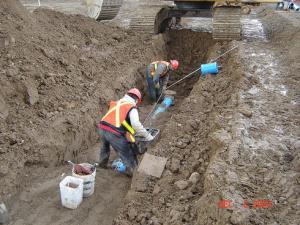Toxic infrastructurePiping as poison: the Flint water crisis and America’s toxic infrastructure
As the crisis over the water in Flint, Michigan, rolls on, we’re learning more and more about the irresponsibility and callousness of officials and politicians in charge. The mix of austerity politics, environmental racism, and sheer ineptitude makes for a shocking brew, yet the physical conditions that have made it literally toxic for Flint residents are neither as exceptional nor as recent as much of the media coverage suggests. An estimated three to six million miles of lead pipes across the United States still carry water, and most all of them are vulnerable to similar dangers, whether at the hands of short-sighted and prejudicial bureaucrats or politicians whose ideology or opportunism leads them to blithely dismiss well-established science. The best solution would be to replace our lead lines systematically and proactively, not just one crisis-beset city at a time. Until we do so, it’s a safe bet that more Flints lie on our horizon.

Crew replacing failed water line // Source: wikipedia.org
As the crisis over the water in Flint, Michigan, rolls on, we’re learning more and more about the irresponsibility and callousness of officials and politicians in charge.
The mix of austerity politics, environmental racism, and sheer ineptitude makes for a shocking brew, yet the physical conditions that have made it literally toxic for Flint residents are neither as exceptional nor as recent as much of the media coverage suggests.
Long before that fateful decision two years ago to turn to the Flint River for the city’s drinking water, pipes made of lead had threaded throughout the city’s underbelly. Flint shares this historical legacy with thousands of other cities, suburbs and towns across our country, and most likely this is not the first time, even in Flint, that these pipes have conveyed tiny amounts of the toxin into homes and children.
Over the past few decades, our environmental laws and agencies have met with much success in curbing some of Americans’ exposure to lead, a damaging neurotoxin. Yet they have struggled to contain this continuing danger precisely because it is literally built into our water systems.
Given that lead has been known as a poison for centuries, why did our forebears in the 19th and early 20th centuries rely on it to carry so vital a fare as drinking water? The answer to this question explains why there are many more Flints waiting to happen.
Lesser evil
In the nineteenth and early twentoeth centuries, from an engineering standpoint, lead seemed superior to concrete or iron, the alternatives at the time when many municipal water systems were being built. Lead is more malleable and thus easier to bend around corners. It also lasts longer.
Doctors offered virtually no resistance to this decision. After all, they themselves were turning to lead to treat diarrhea or trigger abortions. They recognized only those symptoms of lead poisoning that by today’s standards seem extreme: the severe stomach aches, muscle weakness, kidney failure, seizures and even death that can ensue when lead in the blood rises past 60 micrograms per deciliter — 12 times the current standard.
